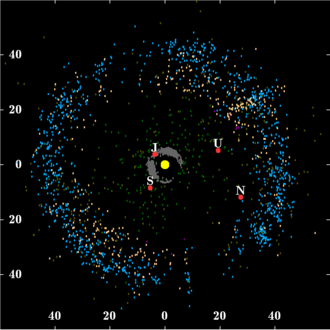Kuiper belt
Kuiper Belt
The Kuiper Belt is a circumstellar disc in the outer Solar System, extending from the orbit of Neptune (at 30 AU) to approximately 50 AU from the Sun. It is similar to the asteroid belt, but it is far larger—20 times as wide and 20 to 200 times as massive. Like the asteroid belt, it consists mainly of small bodies, or remnants from the Solar System's formation. However, while the asteroid belt is composed primarily of rock and metal, Kuiper Belt objects (KBOs) are made largely of frozen volatiles (termed "ices"), such as methane, ammonia, and water. The Kuiper Belt is home to three officially recognized dwarf planets: Pluto, Haumea, and Makemake, as well as many other large bodies.
Discovery and Exploration
The existence of the Kuiper Belt was hypothesized by several astronomers, but it is named after Gerard Kuiper, who in 1951 argued that such a belt was the source of short-period comets. The first Kuiper Belt object (KBO), other than Pluto and its moons, was discovered in 1992. Since then, over 2,000 KBOs have been identified, though it is believed that over 100,000 KBOs exist with diameters larger than 50 kilometers.
Composition and Classification
KBOs are classified into two main groups: the classical Kuiper Belt objects, which have relatively stable orbits and are not in resonance with Neptune, and the resonant objects, which are in orbital resonance with Neptune. The classical objects are further divided into the dynamically "hot" and "cold" populations, based on their inclination and eccentricity.
Significance to Planetary Science
The Kuiper Belt is a key area of study for understanding the early Solar System. The processes that led to its formation are believed to be similar to those that formed the Oort Cloud and the structure of other circumstellar disks observed around other stars. The relatively pristine composition of KBOs provides clues about the early Solar System's chemical makeup.
Missions and Observations
New Horizons is the first and, so far, only mission to visit the Kuiper Belt, conducting a flyby of Pluto in 2015 and the KBO 486958 Arrokoth (previously known as Ultima Thule) in 2019. These missions have provided invaluable data on the physical characteristics and composition of KBOs.
Future Research
Future telescopes, such as the James Webb Space Telescope, are expected to provide more detailed observations of KBOs. Additionally, there are proposals for more dedicated missions to the Kuiper Belt, which would greatly expand our understanding of this distant region of our Solar System.
Transform your life with W8MD's budget GLP-1 injections from $125.
W8MD offers a medical weight loss program to lose weight in Philadelphia. Our physician-supervised medical weight loss provides:
- Most insurances accepted or discounted self-pay rates. We will obtain insurance prior authorizations if needed.
- Generic GLP1 weight loss injections from $125 for the starting dose.
- Also offer prescription weight loss medications including Phentermine, Qsymia, Diethylpropion, Contrave etc.
NYC weight loss doctor appointments
Start your NYC weight loss journey today at our NYC medical weight loss and Philadelphia medical weight loss clinics.
- Call 718-946-5500 to lose weight in NYC or for medical weight loss in Philadelphia 215-676-2334.
- Tags:NYC medical weight loss, Philadelphia lose weight Zepbound NYC, Budget GLP1 weight loss injections, Wegovy Philadelphia, Wegovy NYC, Philadelphia medical weight loss, Brookly weight loss and Wegovy NYC
|
WikiMD's Wellness Encyclopedia |
| Let Food Be Thy Medicine Medicine Thy Food - Hippocrates |
Medical Disclaimer: WikiMD is not a substitute for professional medical advice. The information on WikiMD is provided as an information resource only, may be incorrect, outdated or misleading, and is not to be used or relied on for any diagnostic or treatment purposes. Please consult your health care provider before making any healthcare decisions or for guidance about a specific medical condition. WikiMD expressly disclaims responsibility, and shall have no liability, for any damages, loss, injury, or liability whatsoever suffered as a result of your reliance on the information contained in this site. By visiting this site you agree to the foregoing terms and conditions, which may from time to time be changed or supplemented by WikiMD. If you do not agree to the foregoing terms and conditions, you should not enter or use this site. See full disclaimer.
Credits:Most images are courtesy of Wikimedia commons, and templates, categories Wikipedia, licensed under CC BY SA or similar.
Contributors: Prab R. Tumpati, MD






